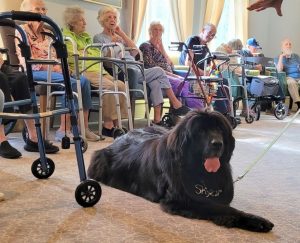Proven Benefits of Animal-Assisted Activities
Since 2019, 1 FUR 1 Foundation has led groundbreaking research on how animal-assisted activity (AAA) sessions positively impact patients health in a group setting. Scientific data confirms that a single AAA session can boost overall mood by 43%, enhance social and communication skills by 33%, and improve cognitive abilities by 11%. These powerful benefits highlight why specially trained therapy animals—from dogs to mini horses—make a remarkable difference in healthcare and emotional wellness.
Animal-Assisted Interactions: Types, Benefits, and Impact
Animal Assisted Activity (AAA) programs utilize pets as therapy to help people with a source of motivation and happiness. The elderly, children and many others benefit immensely from the companionship and opportunity for interaction with animals ranging from cats and dogs to rabbits and llamas. Click here to learn the difference between animal assisted therapy (AAT) vs. animal assisted activities (AAA). Both of these animal assisted interactions (AAI):
- Promotes the release of serotonin, prolactin and oxytocin- all hormones that can play a part in elevating moods
- Help the elderly abate feelings of loneliness
- Increases mental stimulation
- Lowers anxiety and blood pressure with first responders
- Enhances socialization
- Greater use of language for people with autism
- Improves cardiovascular health
- Reduces the amount of medications some people need
Animal Assisted Therapy (AAT) is a goal oriented, planned, structured and documented therapeutic intervention directed by a licensed health and human service providers. AAT sessions can be done in variety of settings by a variety of animals but they must be supervised by a licensed medical professional. The most popular are; Equine Therapy – for people with mental and physical health disabilities and Canine Therapy – for people with emotional and behavioral problems. AAT programs are designed to promote improvement in human physical, social, emotional, or cognitive functions. Center around highly trained and certified therapy dogs and horses that help:
- People receiving cancer treatment
- Children with special needs and ADD/ADHD
- Patients recovering from surgery
- Children with Autism spectrum disorder (ASD)
- Elderly in long-term care facilities and hospice
Expanding Impact
1 FUR 1 is committed to expanding access to animal assisted life-changing interactions by advocating for policy changes at the state and federal levels. Nearly 70% of AAA participants across all age groups experience measurable health improvements in cognitive function, social engagement, and emotional well-being after interacting with therapy animals. Our Animal-Assisted Group Survey—the first of its kind—is a national, voluntary, and anonymous initiative designed to document and validate the benefits of therapy animals in group settings. Together, we are building a future where animal-assisted therapy and activities becomes a widely recognized and accessible form of alternative healthcare.
Resources:
- To register a therapy animal or yourself as a handler, see the requirements from Pet Partners.
- To find a service dog provider near you, visit Assistance Dogs International to accredited nonprofits.
- To certify a mini horse for equine therapy, learn more about the qualification from Metsa.
- See the fact sheet on how to obtain, train and certify a facility dog for your workplace.
- Discover medically substantiated research at the The National Network of Libraries of Medicine,
- PATH Intl. offers certifications and accreditation for professionals or equine centers
- EAGALA trains and certify licensed Mental Health Professionals and qualified Equine Specialists


